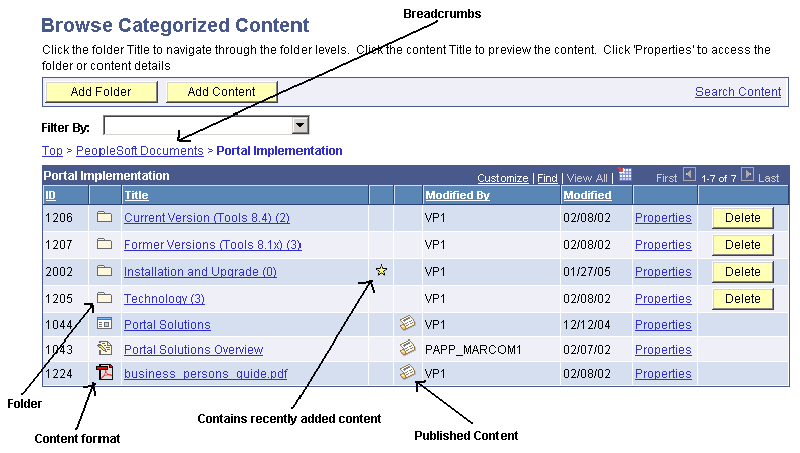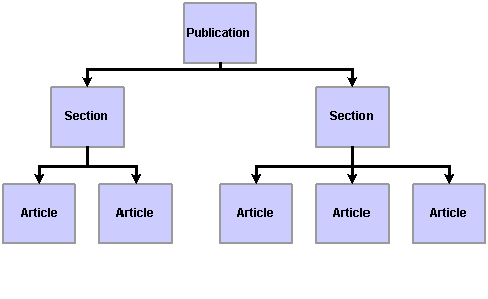 Understanding Browse Folders
Understanding Browse FoldersThis chapter provides an overview of browse folders and discusses how to:
Navigate folder hierarchies.
Access folders and content.
Import managed content.
Note. This chapter describes the basic concepts and functionality of browsing and searching. Differences between the Managed Content,
Categorized Content, and News Publications features are discussed in more detail in later chapters.
Each feature has its own naming convention. Whereas Managed Content uses the term hierarchy, News Publications uses publication. Similarly, Managed Content and Categorized Content use sub-folder, but News Publications uses section. Managed Content and Categorized Content use content, but News Publications uses article, as well as content for articles or images.
This chapter uses the terms hierarchy, sub-folder, and content.
 Understanding Browse Folders
Understanding Browse FoldersBrowse folders functionality is available within Managed Content, Categorized Content, and News Publications, as well as for all folders. This functionality enables users to view folders and content. The user does not have to use the standard search page to select content folders. Starting at the top level folder, users can use any one of the Browse Folders options to drill down through the folder hierarchies to access the content. No administrative privileges are required. However, all users' navigation is unique and automatically displays only the folders for which they are members. Display of the proper content for each user is based upon folder membership and privilege set assignments.
Before displaying items, PeopleSoft Enterprise Portal checks the privilege security that is assigned by the administrator.
To navigate through the folders within the hierarchy:
Click the folder link to drill down into that hierarchy.
Use the navigation path to traverse up to the top level folder.
This sample page illustrates the navigation path, folders, and published content, as well as various actions that are available to the user.

Sample Browse Content (EPPCM_HIER_MAIN) page
In addition to viewing content and navigating through hierarchies, you use Browse Folders to create new hierarchies and publications, add sub-folders, and add or edit content.
See Also
 Navigating Folder Hierarchies
Navigating Folder Hierarchies
This section provides an overview of folder hierarchy rules and discusses how to:
Use top-level browse pages.
Browse sub-level Managed Content or Categorized Content folders.
Browse News Publications folders.
Note. Defining folder properties and setting up their privilege security is not discussed in this chapter because too many variations exist between features.
See Also
Setting Up and Working With Managed Content
Setting Up Categorized Content
Setting Up and Working with News Publications

 Folder Hierarchy Rules
Folder Hierarchy RulesFolder hierarchies and content within Content Management undergo frequent changes. Content is constantly being created, updated, published, relocated, and deleted. Content Management reflects these changes as they occur.
The following rules apply to all Content Management features:
A child folder’s portal name must match the parent folder portal name.
A child folder’s feature type must match the parent feature type.
A folder can have only one parent.
A folder with itself as the parent is a Top Folder.
Content can have multiple parent folders.
Content has a single origin feature type.
Managed Content folders can contain only Managed Content type content.
All non-Managed Content folders can contain only their own feature type content or Managed Content type content.
Content originating from a feature type that is different from the one it is being accessed from can only be viewed unless it has been shared to the Managed Content type.

 Pages Used to Navigate Folder Hierarchies
Pages Used to Navigate Folder Hierarchies
|
Page Name |
Object Name |
Navigation |
Usage |
|
Browse Folders |
EPPCM_HIERTOP_MAIN |
|
Add a new top-level folder or, starting at the top level folders, drill down through folder hierarchies for content that is accessible by that feature. |
|
Browse Managed Content Browse Categorized Content Browse Publication Sections |
EPPCM_HIER_MAIN |
|
Drill down through the folders containing managed content or categorized content. For News Publications, access the Browse Section Articles page. |
|
Browse Section Articles |
EPPCM_HIERNWS_MAIN |
Click a section title on the Browse Publication Sections page. |
Preview articles or access article property details. |

 Using Top-Level Browse Pages
Using Top-Level Browse PagesAccess a Browse Managed Content or Browse News Publications page.
|
Add Top Folder |
Select to create new folder hierarchies or publications. |
|
Search Content |
Click to access the Maintain Content page to access and maintain the properties for the content that you have privileges to view. |
|
Title |
Click to drill down through the folder hierarchy. The bracketed number indicates the number of folders and documents that are located at the next level. This number does not distinguish between folders and documents. |
|
Properties |
Click to go to the Folder Properties page to view or edit property details and security for this folder hierarchy. |
|
Delete |
Click to delete the associated folder. Note. Deleting a folder is allowed only if the folder does not contain any published content. Deleting the folder will cascade the
deletion to all of the folder's sub-folders and child content. |

 Browsing Sub-Level Managed Content or Categorized Content Folders
Browsing Sub-Level Managed Content or Categorized Content FoldersAccess the page by drilling down through the folder hierarchy to access a sub-level Managed Content or Categorized Content browse page.
Sub-level Managed Content and Categorized Content browse pages display basic information about the folders and the content within a folder. Breadcrumbs at the top of the page enable you to navigate to other pages in the hierarchy. A description of the content appears below the breadcrumbs. This description can include HTML that is entered in the summary on the Folder Properties page.
This page provides drill-down access to sub-folders as well as a navigation path to return to the top level. Depending on member privileges for the folder, you can add, edit, delete, or view sub-folders and content
Note. Managed Content and Categorized Content hierarchies may contain many sub-folder levels.
Depending on the feature, Content Management enables you to add different types of content, such as file attachments, web URLs, text or HTML, and image attachments. Based on the type of content that you select, you have a choice of format; for instance, the format for a file attachment can be Microsoft Word or Adobe Acrobat. The image to the left of the title identifies the format that is used for each content item
Click Add Folder to access the Folder Properties page to add a new sub-folder.

 Browsing News Publications Sections
Browsing News Publications SectionsFrom a Browse News Publication page, click a news publication link. The Browse Publications Sections page appears.
Click a publication title link and the Browse Section Article page appears, shown in the following example, appears.
Unlike Managed Content and Categorized Content hierarchies, News Publication hierarchies contain only one section level. The following diagram illustrates a News Publication hierarchy:

Example of a News Publication hierarchy
 Accessing Folders and Content
Accessing Folders and ContentYou can access folders and content within hierarchies through the standard portal search using Search Folders and Maintain Content. These functions are common to the Content Management features. The user sees only content for which he or she has viewer rights, regardless of expiration dates, which enables a user to search through old content.
These are the types of left navigation links used to access folders and content:
Search Folders: Search for Content Management folders that you have privileges to view, and access the children that are associated with the selected folder.
Maintain Content: Access and maintain the properties for the Content Management content that you have privileges to view.
Search All Folders: Search for a folder in all features and sites that you have privileges to view. Access the children that are associated with the selected folder.
Maintain All Folders: Search for a folder in all features and sites that you have privileges to view. Maintain the properties for the selected folders.
Maintain All Content: Search for content in all features and sites that you have privileges to view. Maintain the properties for the content that is stored in the Content Management system.
Search Content: Use Verity to search for content you have privileges to view. Search results link to the first context properties page within the first found location. Content results are only listed once.
Note. The same content item may be listed multiple times. This is because a single content item can be shared across multiple hierarchies, features, and sites.
 Importing Managed Content
Importing Managed Content
This section discusses how to import Managed Content.
You can import Managed Content into publishing features such as News Publication, Categorized Content, Content Pagelets, Manage Navigation, Discussion Forums, Action Items, and Community Calendar Events.

 Page Used to Import Managed Content
Page Used to Import Managed Content
|
Page Name |
Object Name |
Navigation |
Usage |
|
Select Managed Content |
EPPCM_PUB_SELECT |
Click the Add Content button from one of the published features. Select Managed Content and then click OK on the Add Content page. |
Import Managed Content type content into a published feature folder. |

 Importing Managed Content
Importing Managed ContentAccess the Select Managed Content page.
The Select Managed Content page displays only when using Action Items. Other features use a common search page to select Managed Content to import.
Use the Advanced Lookup link to show more selection criteria.
To import managed content:
Browse folders to navigate to the folder where you want to import the managed content.
Click Add Content.
The Add Content page or the Lookup Managed Content search page appears.
Select Managed Content as the content type, and then click OK.
The Select Managed Content page appears.
Enter search criteria to filter the search results.
Click Search.
Select the content item that you want to import by clicking the content title.
The Content Properties page appears with the content item's information. The origin type displays as Managed Content.